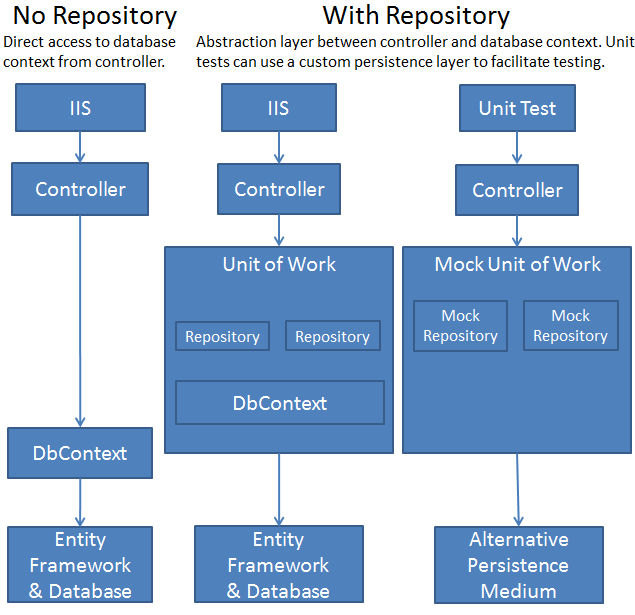I am creating simple web api/ SPA application using EntityFramework, IUnitOfWork, Repository pattern, Unity DI along with Asp.net Identity.
Unity configuration
public static void RegisterTypes(IUnityContainer container)
{
// TODO: Register your types here
container.RegisterType<DataContext>(new PerResolveLifetimeManager());
container.RegisterType<IUnitOfWork, UnitOfWork>(new PerResolveLifetimeManager());
container.RegisterType<IUserStore<User, Guid>, UserRepository>(new HierarchicalLifetimeManager());
container.RegisterType<IUserRepository, UserRepository>(new HierarchicalLifetimeManager());
container.RegisterType<IRoleStore<Role, Guid>, RoleRepository>(new HierarchicalLifetimeManager());
container.RegisterType<IUserManager, ApplicationUserManager>(new HierarchicalLifetimeManager());
container.RegisterType<IRoleManager, ApplicationRoleManager>(new HierarchicalLifetimeManager());
container.RegisterType<IUserService, UserService>(new HierarchicalLifetimeManager());
}
UnitOfWork
public class UnitOfWork : IUnitOfWork
{
protected DataContext _context = null;
public UnitOfWork(DataContext context)
{
if (context == null)
{
throw new ArgumentNullException("Context argument cannot be null in UnitOfWork.");
}
this._context = context;
}
public void SaveChanges()
{
this._context.SaveChanges();
}
public async Task SaveChangesAsync()
{
await this._context.SaveChangesAsync();
}
public void Dispose()
{
if (this._context != null)
{
this._context.Dispose();
}
}
}
GenericRepository
public abstract class GenericRepository<T> : IGenericRepository<T>, IDisposable
where T : class
{
protected DataContext _context;
protected readonly IDbSet<T> _dbset;
public GenericRepository(DataContext context)
{
if (context == null)
{
throw new ApplicationException("DbContext cannot be null.");
}
_context = context;
_dbset = context.Set<T>();
}
//Other code ignored
}
UserRepository - implements IUserStore
public class UserRepository: GenericRepository<User>,IUserRepository
{
public UserRepository(DataContext context)
: base(context)
{
if (context == null)
throw new ArgumentNullException("DbContext cannot be null.");
this._context = context;
}
public async Task CreateAsync(User user)
{
this.CheckParamForNull(user, "User");
this._context.Users.Add(user);
await this._context.SaveChangesAsync();
}
//Other Methods ignored for bravity
}
ApplicationUserManager
public class ApplicationUserManager : UserManager<User, Guid>, IUserManager
{
public ApplicationUserManager(IUserRepository userRepository)
: base(userRepository)
{
this.UserValidator = new UserValidator<User, Guid>(this)
{
AllowOnlyAlphanumericUserNames = false,
RequireUniqueEmail = true
};
// Configure validation logic for passwords
this.PasswordValidator = new PasswordValidator
{
RequiredLength = 6,
RequireNonLetterOrDigit = true,
RequireDigit = true,
RequireLowercase = true,
RequireUppercase = true,
};
}
}
BaseService
public class BaseService
{
IUnitOfWork _unitOfWork = null;
public BaseService(IUnitOfWork unitOfWork)
{
if (unitOfWork == null)
{
throw new ArgumentNullException("DbContext cannot be null.");
}
}
public void Dispose()
{
if (this._unitOfWork != null)
{
this._unitOfWork.Dispose();
this._unitOfWork = null;
}
}
}
UserService
public class UserService : BaseService,IUserService
{
private IUserManager _userManager;
private IUnitOfWork _unitOfWork;
public UserService(IUserManager userManager, IUnitOfWork unitOfWork)
: base(unitOfWork)
{
_userManager = userManager;
_unitOfWork = unitOfWork;
}
public async Task<IdentityResult> RegisterUser(CreateUserBindingModel usr)
{
var user = new User();
user.Email = usr.Email;
user.UserName = usr.Email;
IdentityResult result = await _userManager.CreateAsync(user,usr.Password);
_unitOfWork.SaveChanges();
return result;
}
}
API UserController with Register method
namespace Angular.Api.Controllers
{
[RoutePrefix("api/user")]
public class UserController : ApiController
{
private IUserService _userService;
public UserController()
{
}
public UserController(IUserService userService)
{
_userService = userService;
}
[Route("Register")]
public IHttpActionResult Register(CreateUserBindingModel usr)
{
_userService.RegisterUser(usr);
return Ok();
}
}
}

 from:
from: